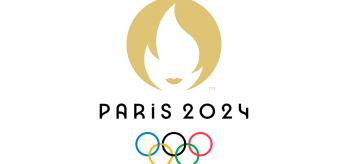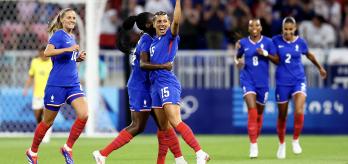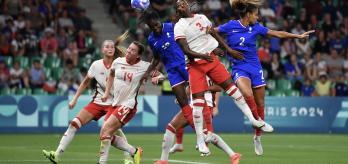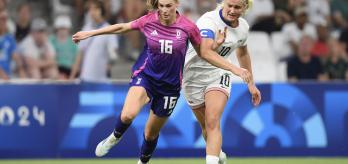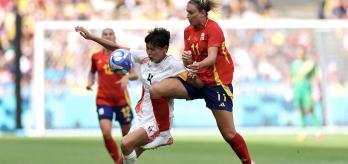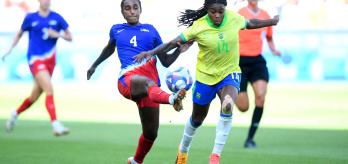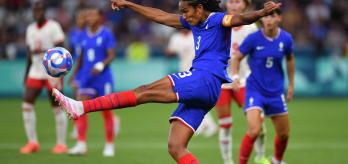Thanks to their specialist data collection methology, the Football Performance Insights Team has the capacity to measure these variables in different phases of the game, and in this article, Pascal Zuberbühler draws on their data to show exactly how goalkeepers are positioning themselves when their teams have possession in the final third.
Line-height increase from FIFA World Cup 2023
Up to and including the semi-finals of the women’s Olympic Football Tournament 2024, it was noticeable that goalkeepers and defensive lines were playing substantially higher up the pitch when their team had the ball in the final third, when compared to the same phase during FIFA Women’s World Cup 2023. At the same time though, the average distance between goalkeepers and their defensive lines was more or less the same as at the World Cup.
At the Olympics, the average goalkeeper line height when their team was in possession in the final third was recorded at 28 metres compared to 24.2 metres during last year’s World Cup – a difference of 3.8 metres. Similarly, the average defensive line height in the same phase also increased, by 3.6 metres to 57.4 metres. This means that, despite both the goalkeeper and defensive lines being positioned higher up the pitch, the distances between them in this phase is virtually the same: it was 29.4 metres at the Olympics compared to 29.6 metres at the World Cup, a difference of just 0.2 metres.
This development caught the eye of the TSG’s resident goalkeeping expert, Pascal Zuberbühler:
“This is very interesting to see, and these numbers support what we have been observing on the pitch”, he said. “Teams are playing higher as a whole and as connected units, meaning they have numbers to support attacking play and to initiate a counter-press if they lose the ball, so having their goalkeeper higher up also means they have a spare player to use to recycle possession and to play out of pressure zones. Crucially though, the goalkeeper must be able to defend the space behind the defensive line by being positioned higher and close to their defensive line.”
Defending the space
When the goalkeeper’s team are in possession in the final third and playing with a high defensive line, there is more space available behind the defence. The goalkeeper has an important role to play in defending this space should their team have to transition to defend. There is no consensus regarding a perfect starting position for a goalkeeper in this scenario; the important thing is that, regardless of their preferred starting position, they must be able to cover and defend the space.
Examples of defending the space
In the clips below, Zuberbühler highlights some examples of goalkeepers defending the space in behind their defensive line when their team is in possession in the final third.
Kailen Sheridan - Canada
“In clip 1, we see Canada goalkeeper Kailen Sheridan (1) defending the space when her team loses the ball high up the pitch. As soon as New Zealand transition to attack, they play consecutive forward passes to try to access the space in behind Canada’s high defensive line, but Sheridan is connected to her team (they expect her to be there) and she retrieves the ball 32 metres from her goal line. She can read that an attempt at goal is unlikely to be successful from the point of the second forward pass, so she can stay high, defend space and regain possession for her team. When she does receive the ball, she immediately gets offers to receive from two team-mates, and her forward pass around New Zealand’s defensive shape initiates a goal-scoring attacking phase,” he explains.
Cata Coll - Spain
Clip 2 shows a slightly different scenario. Here, Spain’s Cata Coll (13) is starting from a deeper position. When her team lose the ball following an attacking corner, Colombia look to break forward quickly. As Linda Caicedo (18) drives forward with the ball, Spain’s nearest defenders try to slow her down to buy time for more players to recover into a defensive shape and get behind the ball. Initially, they manage to put pressure on the ball, denying an opportunity for a long-range attempt at goal, but when Caicedo cuts inside and finds some space, we immediately see Coll retreating towards her penalty area to a position 18 metres from her goal line. When Caicedo opts for a ball in behind the defensive line as opposed to an attempt at goal, Coll immediately takes explosive forward steps towards the ball, gaining 6 metres of territory. As soon as she intercepts the ball, her defender wide on the left offers to receive, and she plays a first-time pass.
This passage of play underscores the importance of the relationship between goalkeepers and their defenders. As Zuberbühler explains, “This relationship between the outfield players and their goalkeepers is crucial. Defenders can trust their goalkeeper to defend the space in behind them and the goalkeeper can trust her outfield players to make themselves available, so she has options to play forward.”
Chiamaka Nnadozie - Nigeria
Finally, in the third clip, Nigeria goalkeeper Chiamaka Nnadozie (16) makes a defensive intervention following a failed high press from her team. The long ball over the top of her defensive line gives her a complex decision to make. As the ball bounces in the space behind her defensive line, her right centre-back is involved in an aggressive 1v1 sprint with Colombia’s forward, while Nnadozie is positioned in the space, 22 metres from her goal line.
This is where communication is key, as Zuberbühler points out, “Communication in this situation is crucial, and fast decision-making, too. She has only a split second to read the situation and sees her defender is fully engaged with the attacker, but the first bounce indicates that the ball will come to Nnadozie before the duelling players can get to it. She intervenes and clears the ball from danger but it is clear that her high starting position is the key factor in her ability to defend the space in this situation. Again, this position takes courage and game awareness.”
SUMMARY
Goalkeepers and their defensive lines are playing higher in the women’s Olympic Football Tournament compared to FIFA Women’s World Cup 2023, yet the distance between them has changed very little between the two competitions. Whenever they play a high line, it is vitally important that teams know where the goalkeeper will be. Mutual trust between goalkeepers and their defences is key to defending the space in behind, because it allows goalkeepers to stop opposition attacks earlier, regain possession, and use it to their team’s advantage.




